-
Text Color





-
Text Size



-
Contrast




.jpg)
MYCENSUS 2020 RECORDED POPULATION OF 32.4 MILLION PERSONS TO BECOME A NEW BENCHMARK (BASELINE) TO DRIVE THE NATIONAL SOCIO-ECONOMIC PLANNING AND PROSPERITY
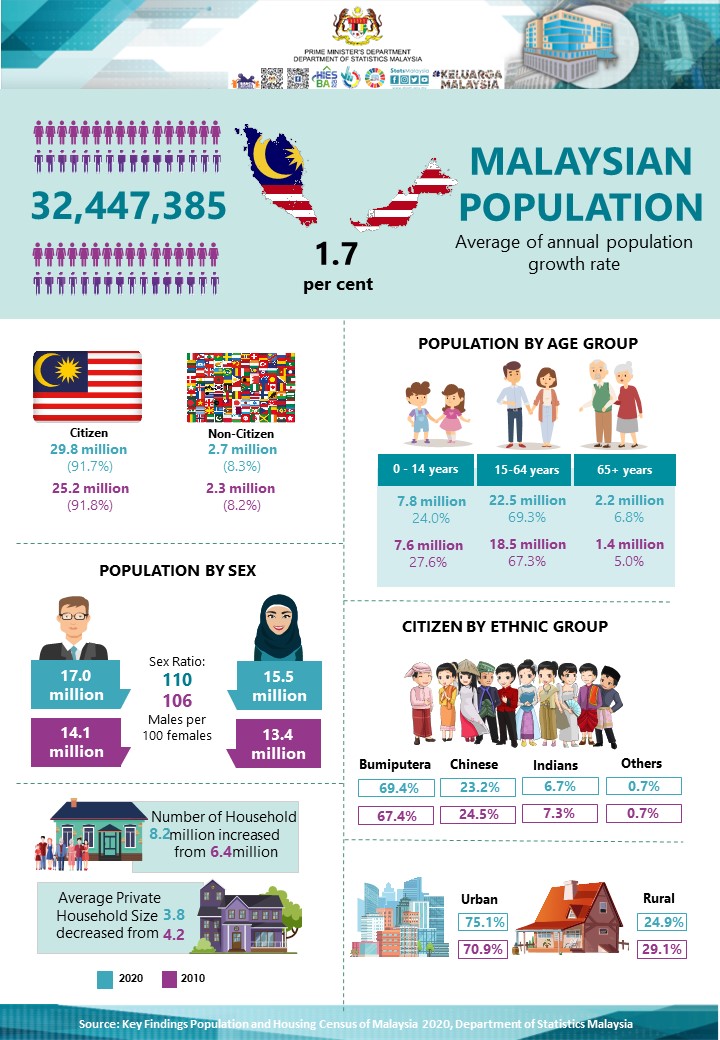
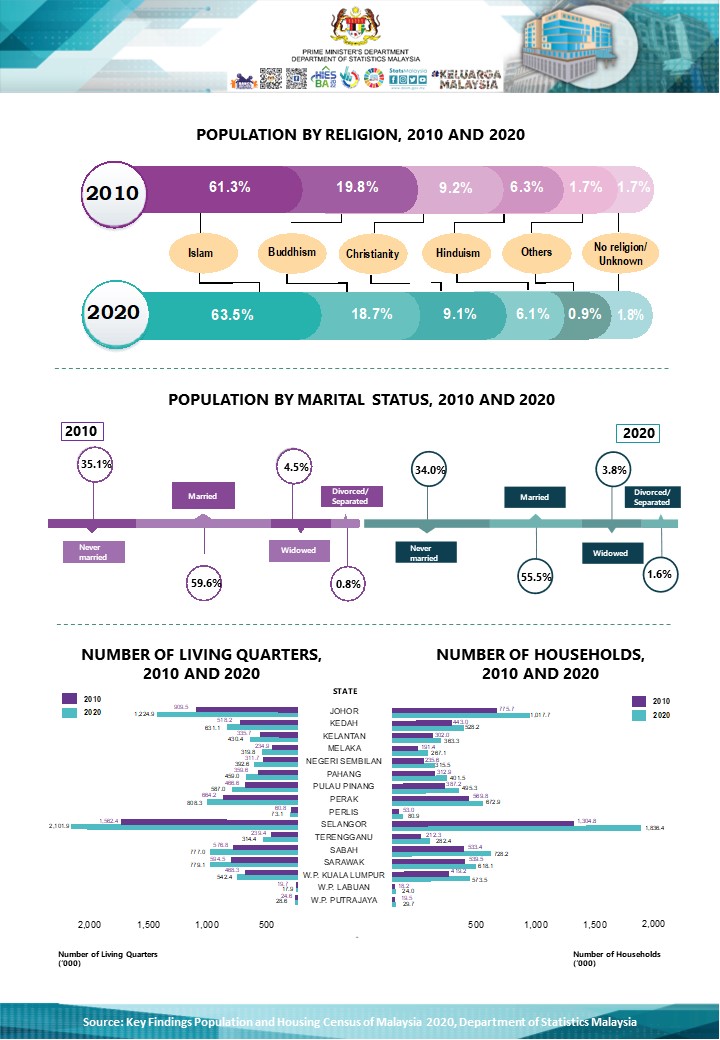
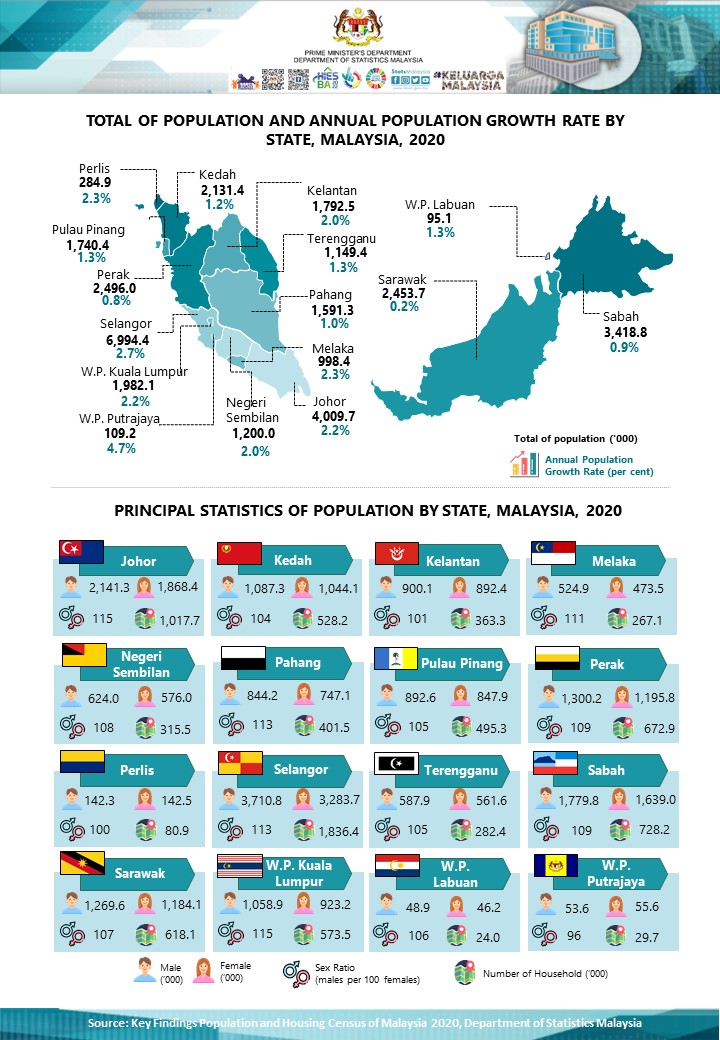
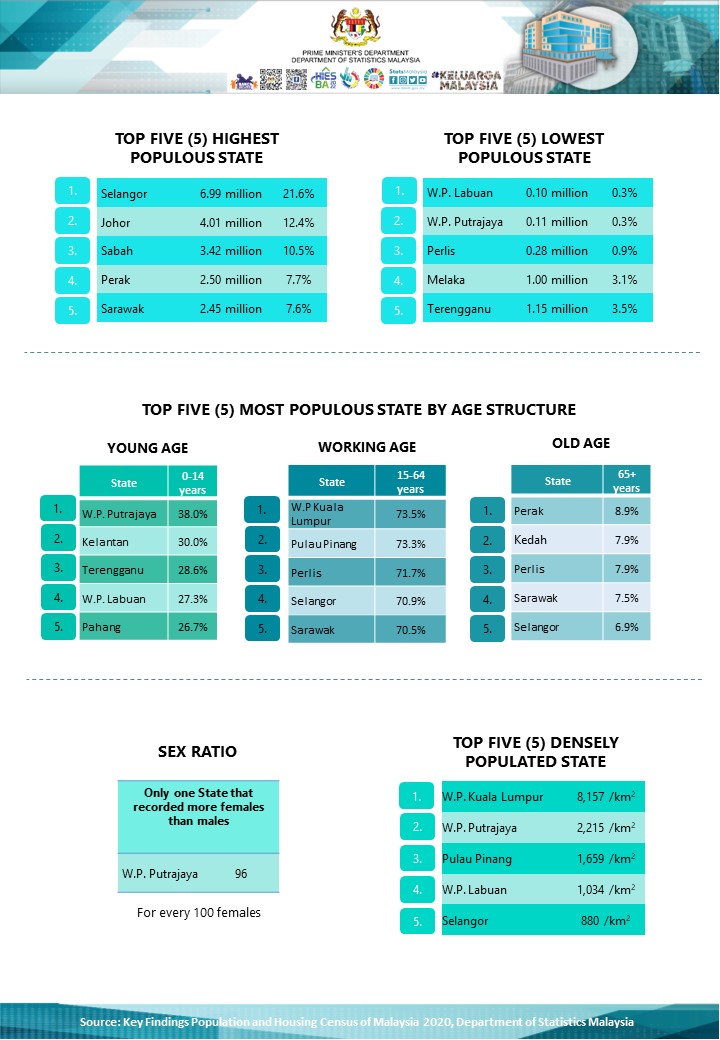
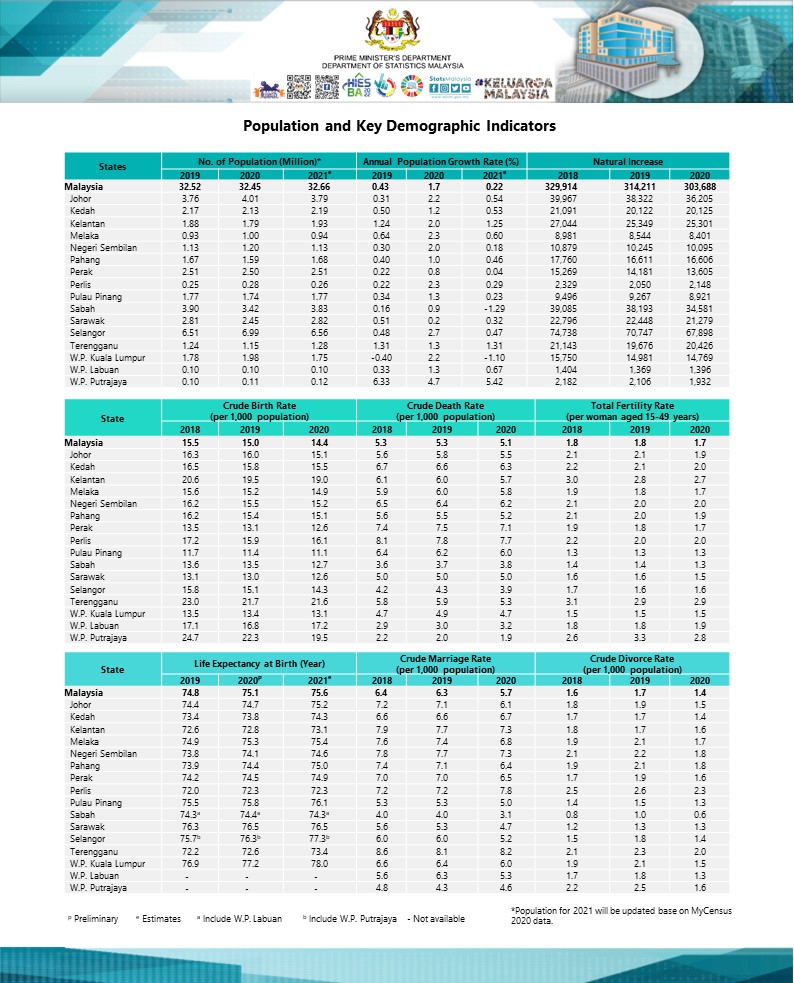
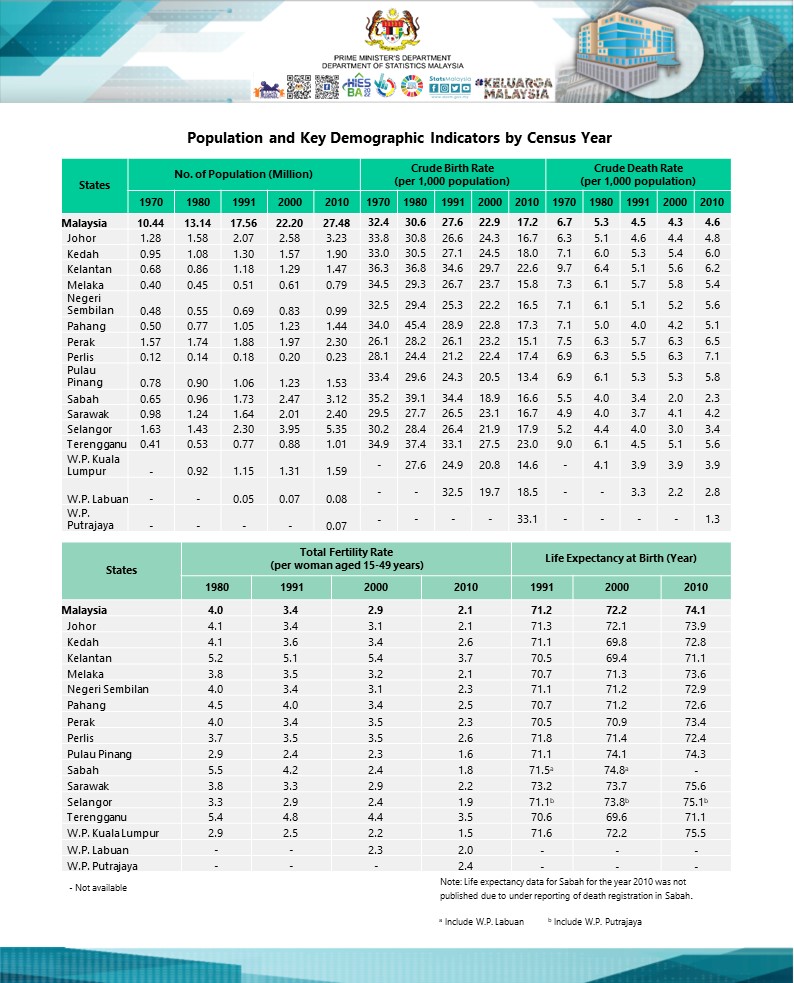
SHAH ALAM, 14 February 2022 - YAB Dato’ Sri Ismail Sabri bin Yaakob, Prime Minister has officiated the Launching of Key Findings Population and Housing Census of Malaysia 2020 (MyCensus 2020) Report at the Management & Science University (MSU) today. Present at the ceremony was YB Dato’ Sri Mustapa bin Mohamed, Minister in the Prime Minister's Department (Economy), YBhg. Professor Tan Sri Dato’ Wira Dr. Mohd Shukri Ab Yajid, Chairman of MSU and YBhg. Dato’ Sri Dr. Mohd Uzir Mahidin, Chief Statistician of Malaysia and Census Commissioner of MyCensus 2020.
Implementation of MyCensus 2020 was approved through the Cabinet Meeting on 12 July 2017 is the sixth Census and it is implemented based on the Federal Constitution (Articles 74, 77, 109 and 112C), the Census Act 1960 (Revised 1969) and the Statistics Act 1965 (Revised 1989). Based on the Gazette of the Census Direction and Appointment of Commissioner of Census dated 11 February 2020, His Majesty the Yang di-Pertuan Agong agreed to direct the Population and Housing Census to be carried out throughout Malaysia.
The implementation of MyCensus 2020 is the sixth Census undertaken after the establishment of Malaysia in 1963. The undertaking of Census is based on the Federal Constitution (Articles 74, 77, 109 and 112C), the Census Act 1960 (Revised 1969) and the Statistics Act 1965 (Revised 1989). The Cabinet Meeting on
12 July 2017 has agreed for the Department of Statistics to carry out the Population and Housing Census in 2020. Based on the Federal Government Gazette of the Census Direction and Appointment of Commissioner of Census dated 11 February 2020, His Majesty the Yang di-Pertuan Agong has ordered that the Population and Housing Census to be undertaken throughout Malaysia while the Chief Statistician of Malaysia has been appointed as the Census Commissioner effective 1 April 2019.
De jure approach is used where the information of each population is collected according to their usual place of residence on census day 7 July 2020. His Majesty the Yang Di-pertuan Agong has agreed to be the first respondent to complete the Census online using e-Census platform. Following that, the Census began simultaneously throughout Malaysia on 7 July 2020. The Launching Ceremony of MyCensus 2020 was held on the same date. The governance of MyCensus 2020 consists of Census Steering Committee chaired by the Chief Secretary to the Government and Census Main Committee chaired by the Chief Statistician of Malaysia as the Census Commissioner, and involves various agencies at the federal and state levels including Deputy Commissioners, Assistant Commissioners and District Superintendents. In addition, nearly 8,000 Supervisors and 40,000 Enumerators have been appointed for the period 2017 to 2022.
The implementation of MyCensus 2020 utilises the usage of ICT through the modernisation and integration of the Malaysia Integrated Population Census System (MyIPCS). MyCensus 2020 data collection operation which started on 7 July 2020 has ended on 31 October 2021 using the mode of e-Census, Computer-Assisted Personal Interview (CAPI), Computer Assisted Telephone Interview (CATI), Paper & Pen Interview (PAPI) and Drop Off & Pick Up (DOPU). Based on MyCensus 2020 operation, 23.7 per cent of the population was enumerated online through e-Census and CATI modes and 76.3 per cent through face-to-face via CAPI, PAPI and DOPU modes. Of the 76.3 per cent face-to-face interview, 68.2 per cent were through CAPI (hybrid mode of online and face-to-face enumeration) and 8.1 per cent were counted via PAPI and DOPU. Thus, the current census is carried out by adapting the digital transformation and 91.9 per cent was electronic based (paperless). The challenge of conducting recent Census was the outbreak of COVID-19 situation. Thus, the Census data collection operations were rescheduled four times during the period of July 2020 to October 2021. Preliminary data was announced during the close of census operations on 1 November 2021.
An integrated management has been introduced by DOSM by developing a secured, comprehensive and interactive census portal (www.mycensus.gov.my) for the purpose of implementing the MyCensus 2020. This portal is an information gateway that provides various census information in the form of infographics, interactive visualizations and various online applications such as Stats Geoportal which provide census data in an interactive geospatial format for the smallest geographical area level up to the district level. A special platform, MyCensus 2020 dashboard has been developed to provide data at finger tips to fulfil stakeholders’ need in socio-economic development planning. Indirectly, it can bridge the digital divide in accessing diverse and complex data sources.
MyCensus 2020 comprises 108 questions is a high-impact investment to the nation (RM413.9 million) produces new National baseline data on social, economic and environmental statistical dimensions. Meanwhile, the main demographics obtained from the MyCensus 2020 include population, households, living quarters, sex, age, citizenship, ethnicity, religion and marital status. More than 1,000 MyCensus 2020 reports covering 16 states, 160 administrative districts, 222 parliaments and 600 state legislative assemblies will be published in stages from February 2022 to 2024.
YAB Prime Minister said, “The findings of MyCensus 2020 will be used as a new benchmark for the Government to outline policies related to the development of people's well-being, in addition to providing comprehensive input in the implementation of existing policies such as Vision 2030 Common Prosperity, 12th Malaysia Plan, the 2030 Agenda for Sustainable Development Goals (SDGs)”. The findings of MyCensus 2020 also serve as a catalyst towards achieving the vision of the Keluarga Malaysia.
In producing population and demographic statistics through the implementation of the MyCensus 2020, collaboration and strategic cooperation between the Department of Statistics Malaysia (DOSM) with Ministries and Agencies, State Governments and Local Authorities as well as the private sector and the general public have been closely intertwined to ensure the integrity of data.
"DOSM would like to thank the Government for entrusting DOSM in leading the implementation of the sixth Census and I also express my highest appreciation for my appointment as the sixth Malaysian Census Commissioner in guiding the planning, operation, analysis and dissemination of Census findings," he said. YBhg. Dato’ Sri Dr. Mohd. Uzir Mahidin, Chief Statistician of Malaysia and Commissioner of the MyCensus 2020.
Brief report on Key Findings Population and Housing Census of Malaysia 2020 is per Appendix 1 and can be accessed on the MyCensus 2020 Dashboard on the MyCensus 2020 Portal (www.mycensus.gov.my). This dashboard will be updated from time to time. Meanwhile, a holistic interactive census portal is also being developed towards the dissemination of attractive and user -friendly census data.
The Department of Statistics Malaysia is conducting the Income, Household Expenditure and Basic Amenities Survey (HIES/BA) 2022 starting from 1 January 2022 to 31 December 2022. The department greatly appreciates the cooperation of the selected respondents to provide information to DOSM officers as well as the success of this survey. Please visit www.dosm.gov.my for more information.
APPENDIX 1
BRIEF REPORT ON KEY FINDINGS POPULATION AND HOUSING CENSUS OF MALAYSIA 2020
Population of Malaysia
The total population of Malaysia in 2020 was 32.4 million as compared to 27.5 million in 2010. Malaysia's population grew at a slower rate of 1.7 per cent a year between 2010 and 2020 as compared to 2.2 per cent a year between 2000 and 2010.
Living Quarters
Malaysia’s living quarters in 2020 amounted to 9.6 million which includes 7.7 million occupied dwellings and 1.9 million were vacant. Of the 7.7 million occupied dwellings, 98.9 per cent were private living quarters and 0.9 per cent were collective living quarters such as student hostels, workers' hostels, care centres for the elderly, prisons, medical institutions and others. The remaining of 0.2 per cent are non-residential premises that have been used as living quarters such as offices and schools. The highest number of living quarters was recorded in Selangor at 2.1 million (21.9%), followed by Johor (1.2 million; 12.9%) and Perak (0.8 million; 8.4%). The lowest number of living quarters was W.P. Labuan amounted to 22.9 thousand (0.2%).
Households
Total households in Malaysia was 8.2 million in 2020, up 1.9 million or 2.6 per cent growth from 6.35 million or 2.9 per cent growth in 2010. Of the total 8.2 million households, 97.3 per cent were private households. The highest households by state were in Selangor (1.8 million; 22.3%), followed by Johor (1.0 million; 12.4%) and Sabah (0.7 million; 8.8%). The administrative districts that recorded the highest number of households were Petaling, Selangor (617.7 thousand; 33.6%), Johor Bahru, Johor (460.7 thousand; 45.3%) and Ulu Langat, Selangor (387.6 million; 21.1%).
Single households amounted to 0.96 million or 12.0 per cent with the highest number recorded in Selangor (189.4 thousand; 10.7%) and Johor (117.6; 11.8%). The average size of private households declined to 3.8 as compared to 4.2 in 2010. The distribution by state showed that Kelantan had the highest at 4.8, followed by Sabah (4.7) and Terengganu (4.1). Meanwhile, for the administrative district, Kunak in Sabah recorded the highest average private household size (5.8), followed by Semporna, Sabah (5.7), Nabawan and Sandakan, Sabah (5.3) and Tumpat, Kelantan (5.2).
Population by State and Administrative District
The state of Selangor recorded the highest population of 6.9 million (21.6%), followed by Johor 4.0 million (12.4%) and Sabah 3.4 million (10.5%). Meanwhile, Wilayah Persekutuan (W.P.) Labuan recorded the lowest population of 95.1 thousand (0.3%) and Perlis 284.9 thousand (0.9%). The population by administrative district of more than one million was in Petaling, Selangor (2.3 million persons), Johor Bahru, Johor
(1.7 million persons), Ulu Langat, Selangor (1.4 million persons), and Klang, Selangor (1.1 million persons).
The highest annual growth during 2010 and 2020 by state was W.P. Putrajaya at 4.8 per cent and Selangor at 2.7 per cent. The highest annual growth in the same period by administrative district level was Sepang, Selangor (4.6%), followed by Samarahan, Sarawak (4.1%) and Alor Gajah, Melaka (3.7%).
Population by Sex
The composition of Malaysia's population consists of 17.0 million or 52.3 per cent males, as compared to 15.5 million (47.7%) females. Compared to a decade ago, the sex ratio increased to 110 males for every 100 females (2010: 106). The highest sex ratio was recorded in Johor and Kuala Lumpur at 115, followed by Pahang and Selangor (113) and Melaka (111). The lowest sex ratio was recorded in W.P. Putrajaya (96), which means females outnumbered males in W.P. Putrajaya. The highest sex ratio that showed more males than females at the administrative district level are in Bukit Mabong, Sarawak (157), Belaga, Sarawak (136), Cameron Highlands (132) and Bentong, Pahang (131).
Population by Citizenship Status
The population of Malaysia comprises 91.7 per cent of Citizens amounting to 29.8 million and 8.3 per cent of Non-Citizens accounted 2.7 million. The Citizens population grew at a slower rate of 1.7 per cent (2010: 1.9%) per annum between 2010 and 2020, while Non -Citizens increased 1.8 per cent per annum over the same period.
Population by Ethnic Group
The composition of population by ethnicity showed that there were 20.6 million (69.4%) Bumiputera, Chinese 6.9 million (23.2%), Indians 2.0 million (6.7%) and Others 215.6 thousand (0.7%). The Bumiputera comprised Malays, Orang Asli, Sabah Bumiputera and Sarawak Bumiputera. Bumiputera is the main ethnic group in all states except Pulau Pinang and W.P. Kuala Lumpur. W.P. Putrajaya (97.9%), Terengganu (97.6%) and Kelantan (96.6%) were the states with the highest Bumiputera composition. In contrast, the Chinese ethnic composition was the highest in Pulau Pinang (44.9%), W.P. Kuala Lumpur (41.6%) and Johor (32.8%). The composition of Indians ethnic was the highest in Negeri Sembilan (14.3%), Perak (11.5%) and Selangor (11.3%).
The major ethnic for Sabah Bumiputera comprised Kadazan/ Dusun which recorded the highest population of 698.3 thousand, followed by Bajau (592.4 thousand persons) and Murut (112.9 thousand persons). The highest Sarawak Bumiputera ethnic groups were Iban (753.5 thousand persons), Bidayuh (215.7 thousand persons) and Melanau (142.4 thousand persons).
Population by Age Group
There was a total of 7.8 million persons in the 0-14 age group (young age), accounting for 24.0 per cent; 22.5 million persons aged 15-64 years (working age) accounted for 69.3 per cent; and 2.2 million persons in the age group of 65 years and over (old age), accounted 6.8 per cent.
The highest young age population composition (0-14 years) by state was in W.P. Putrajaya (38.0%), Kelantan (30.0%) and Terengganu (28.6%). The composition of the working age population (15-64 years) was the highest in W.P. Kuala Lumpur (73.5%), Penang (73.3%) and Perlis (71.7%). The composition of the elderly population (65 years and over) was the highest in Perak (8.9%), Perlis and Kedah (7.9%) and Sarawak (7.5%). The oldest resident recorded was 120 years old male citizen and lives in Mersing, Johor.
Population by Religion
Muslims in 2020 amounted 20.6 million, Christians 2.9 million, Buddhists 6.1 million, Hindus 2.0 million and Others 860 thousand. The highest number of Muslims was in Selangor, while the highest number of Christians were in Sarawak. Selangor was also the state with the highest number of Buddhists and Hindus.
Population by Marital Status
Marital status shows that the population who has never been married was 8.4 million or 34.0 per cent from 24.7 million population aged 15 years and above. Married was 13.7 million (55.5%), Widowed/ Widower was 946.2 thousand (3.8%) and Divorced/ Separated was 393.4 thousand (1.6%).
The highest number of never been married person by state was recorded in Selangor at 1.7 million, Johor (1.1 million) and Sabah (0.9 million). The highest number of married persons by state was recorded in Selangor at 3.0 million, Johor (1.8 million) and Sabah (1.4 million). The highest number of widows/ widowers were in Perak (117.4 thousand), Johor (113.4 thousand) and Selangor (102.2 thousand). The population with Divorced/ Separated status was the most in Selangor (91.7 thousand), Johor (46.7 thousand) and Sarawak (37.8 thousand).
On average, Malaysia has a population density of 98 persons per square kilometre in 2020 as compared to 83 persons per square kilometre in 2010. W.P. Kuala Lumpur has the highest population density with 8,157 persons per square kilometre, followed by W.P. Putrajaya (2,215 persons) and Penang (1,659 persons). Sarawak has the lowest population density with 20 persons per square kilometre, followed by Pahang (44 persons) and Sabah (46 persons). In terms of administrative districts, Petaling, Selangor is the most densely populated administrative district with 4,719 persons per square kilometre, followed by the Timur Laut, Pulau Pinag (4,403) and Seberang Perai Tengah (1,779 persons).
Urbanisation
The urbanisation rate in Malaysia increased to 75.1 per cent (24.3 million persons) in 2020 as compared to 70.9 per cent (19.5 million persons) in 2010. Meanwhile, the population of rural area declined to 24.9 per cent in 2020 as compared to
29.1 per cent in 2010. W.P. Kuala Lumpur and W.P. Putrajaya have 100 per cent of the population living in urban areas. Besides that, Selangor was the state with the highest composition of urban population at 95.8 percent (2010: 91.3%), followed by Pulau Pinang 92.5 percent (2010: 90.7%) and Melaka 90.9 percent (2010: 86.5%).
Subnational Statistics of Parliament and State Legislative Assembly (DUN) Catalyst for Socioeconomic Development of Local Communities
The Department of Statistics Malaysia has made another history of producing comprehensive economic and social statistics with more targeted geographical details up to the Parliament and State Legislative Assembly (SLA) levels.
Subnational Statistics of Parliament and State Legislative Assembly (SLA) were published for the first time in conjunction with the release of Population and Housing Census of Malaysia 2020 report for all 222 parliaments and issuing 36 publications covering the Negeri Sembilan State Legislative Assembly.
This publication covers 12 socio-economic statistics consisting of basic information indicators; population; housing; labour force; household income; education; health; poverty; public safety; internet and social media, and basic amenities. The publication which contains the of each Parliament also contain statistics on the number of business establishments operating by economic sector according to Parliamentary constituencies such as petrol stations, private kindergartens, laundry shop, grocery stores, car workshops and private dental clinics.
The availability of statistics at small areas which are Parliament and DUN level are important and beneficial, especially to the Members of Parliament and State Assemblymen. Such statistics are useful in improving the governance and the rakyat’s well-being.
The main findings of the Subnational Statistics Parliaments show that the three most populous parliaments located in Selangor namely Parliament of Bangi (P.102) having a total of 688 thousand persons followed by Kota Raja (P.111) with 523 thousand persons and Subang (P.104) with 478 thousand persons. Bangi also recorded the highest number of households and living quarters (LQ) at 182,471 persons and 200,957 LQ. The Parliament of Jelutong (P.050) has the highest population density of 33,287 per square kilometre, followed by Tanjong (P.049) with 26,963 populations and Pandan (P.100) with 24,229 persons per square kilometre.
The two parliaments in the state of Sarawak, namely Hulu Rajang (P.216) and Baram (P.220), are the two parliaments with the largest area of 34,080 square kilometres and 22,075 square kilometres respectively followed by Kinabatangan (P.187) in Sabah with an area of 18,068 square kilometres. Hulu Rajang Parliament (P.216) and Baram (P.220) also have the highest government Health Clinic at 14 and 25. Baram Parliament also has the highest number of schools with 78 primary schools and eight secondary schools. Other parliaments with the highest number of primary schools are Kudat (P.167) with 71 schools and Setiu (P.034) with 64 schools, while the number of secondary schools are 13 and 20 respectively.
Three parliamentary constituencies in Selangor recorded the highest number of business establishments, namely Petaling Jaya (P.105) at 33,902, followed by Bukit Bintang (P.120) at 31,784 and Damansara (P.106) at 31,559 business establishments. Parliament in Selangor also has the highest basic facilities such as petrol stations, car workshops and many more. The Parliament of Segambut (P.117), Kepong (P.114) and Seputeh (P.122) recorded the highest median monthly household income of RM13,357, RM11,274 and RM11,113, respectively.
The publication released today will continue to be updated and become an important reference in decision-making, input policy-formulation, monitoring and evaluation of the effectiveness of national development programmes as well as research.
This publication can be accessed and free download through the eStatistik on the DOSM portal, www.dosm.gov.my.
Released By:
DATO' SRI DR. MOHD UZIR MAHIDIN
CHIEF STATISTICIAN MALAYSIA
DEPARTMENT OF STATISTICS, MALAYSIA
![]() DrUzir_Mahidin
DrUzir_Mahidin ![]()
![]() Dr_Uzir
Dr_Uzir
14 February 2022
Contact person:
Mohd Yusrizal Ab Razak
Public Relation Officer
Strategic Communication and International Division
Department of Statistics, Malaysia
Tel : +603-8885 7942
Fax : +603-8888 9248
Email : yusrizal.razak[at]dosm.gov.my